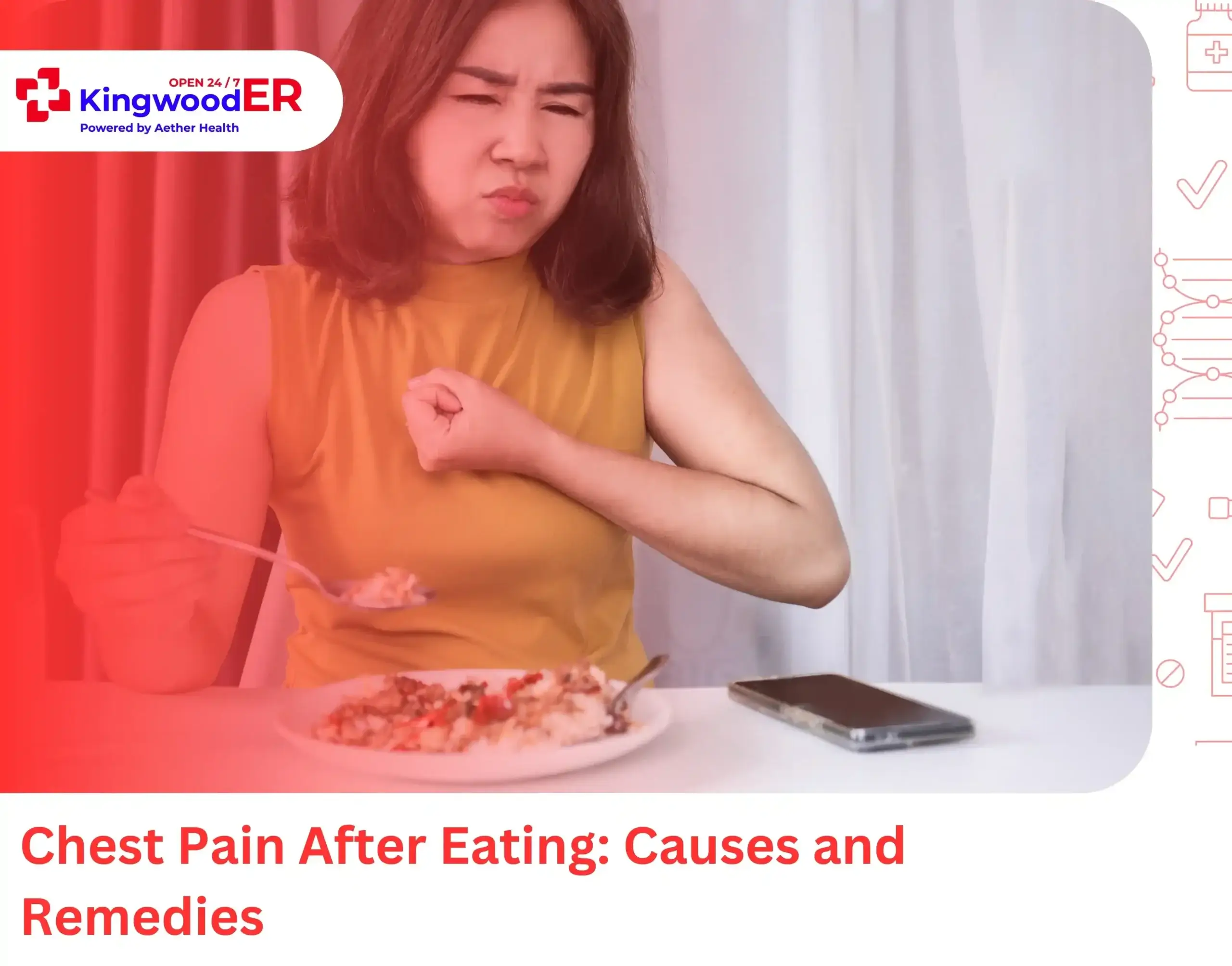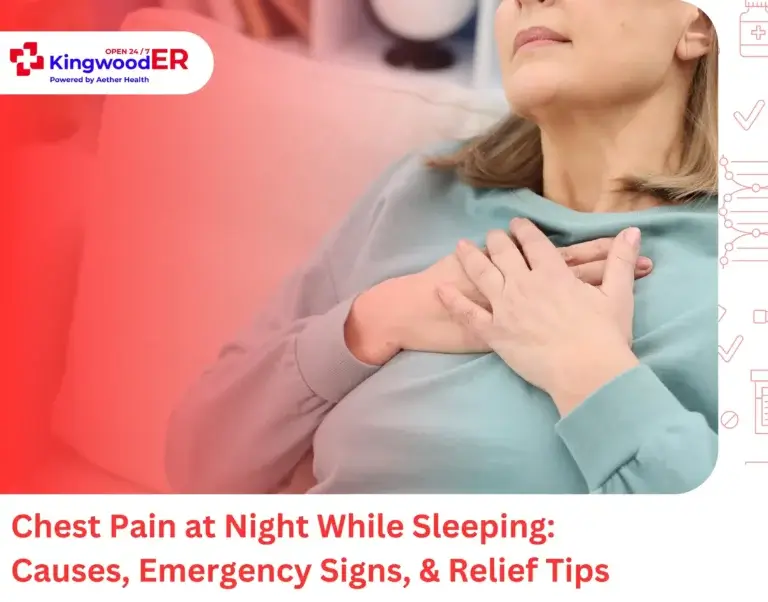Chest tightness, burning after meals, or pressure that feels like it’s sitting right behind your ribs, if you’ve ever had chest pain after eating, you know how unsettling it can be.
The first thought is often the heart, but in many cases, the real culprit is your digestive system. The good news? Most causes are manageable once you know what’s triggering them.
Let’s break down the common reasons for chest pain after eating, when it’s a red flag, and simple steps you can take to find relief.
Common Causes of Chest Pain After Eating
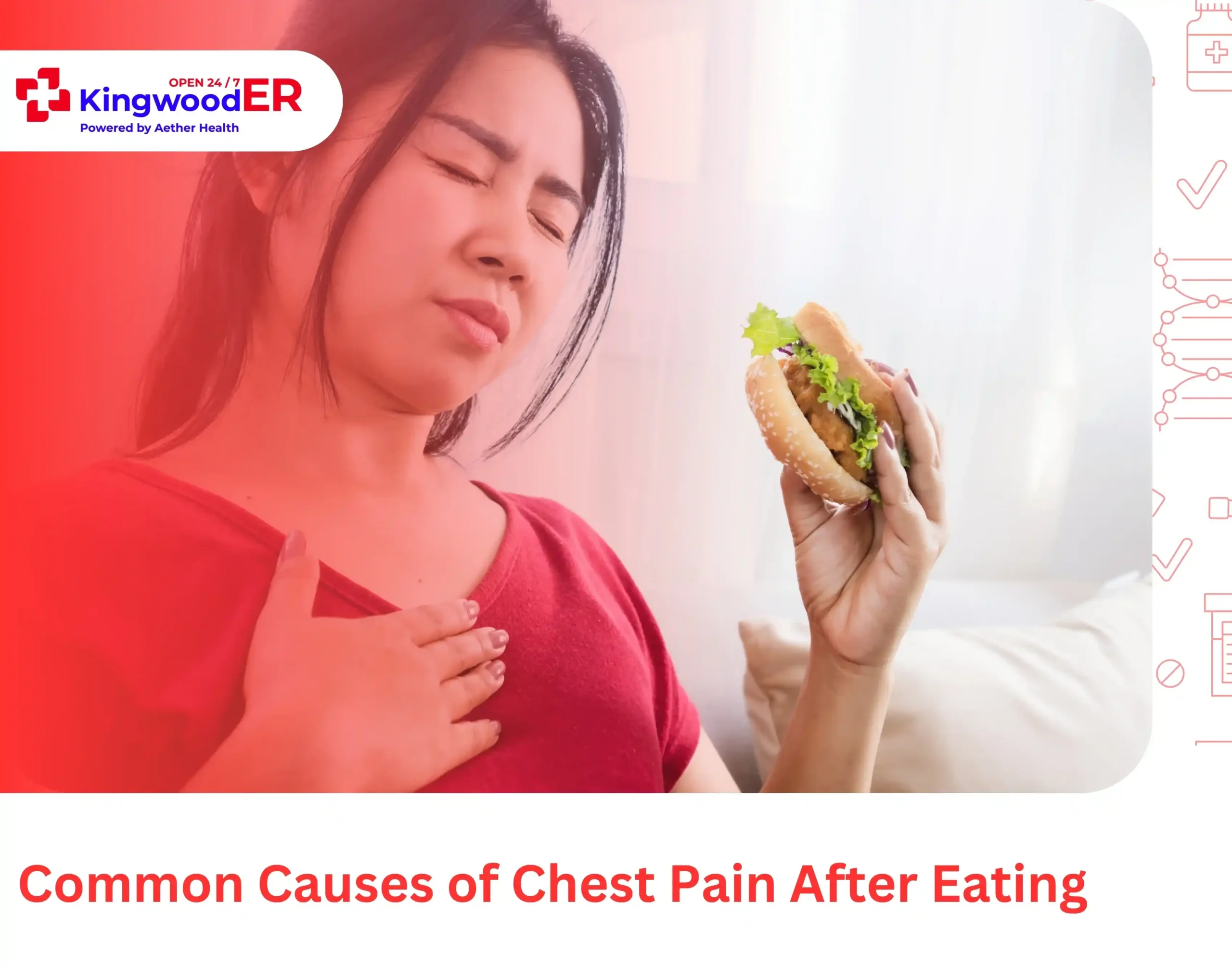
Gastroesophageal Reflux Disease (GERD)
One of the most frequent causes behind chest pain after eating is GERD, a condition where stomach acid flows back into the esophagus. This acid reflux can cause a burning sensation in the chest, often mistaken for heart-related pain. The pain typically occurs within 30 minutes to two hours after eating, especially after consuming large meals, spicy foods, citrus fruits, or caffeinated beverages.
GERD-related chest pain after eating often worsens when lying down or bending over, and may be accompanied by heartburn, regurgitation, or a sour taste in the mouth. The esophageal irritation caused by stomach acid can create intense discomfort that radiates from the lower chest upward.
Esophageal Spasms
Esophageal spasms occur when the muscles in the esophagus contract irregularly, causing severe chest pain that can mimic heart attack symptoms. These spasms can be triggered by eating too quickly, consuming very hot or cold foods, or swallowing large pieces of food. The pain from esophageal spasms typically feels like a crushing sensation in the chest and may last from minutes to hours.
Food Allergies and Intolerances
Certain food allergies or intolerances can result in chest pain after eating. Lactose intolerance, gluten sensitivity, or allergic reactions to nuts, shellfish, or other allergens can cause chest discomfort along with other symptoms like bloating, nausea, or difficulty breathing.
Hiatal Hernia
A hiatal hernia occurs when part of the stomach pushes through the diaphragm into the chest cavity. This condition can cause chest pain after eating, particularly after large meals. The displaced stomach tissue can put pressure on surrounding organs and cause acid reflux, leading to chest discomfort that may worsen when lying down.
Gallbladder Problems
Gallbladder issues, including gallstones or inflammation, can cause chest pain after eating fatty or greasy foods. This pain typically starts in the upper right abdomen but can radiate to the chest, shoulder, or back. Gallbladder-related chest pain often occurs 30 minutes to several hours after consuming trigger foods.
Cardiac vs Non-Cardiac Chest Pain
While chest pain after eating is usually digestive in nature, it’s important to recognize the signs that might indicate a cardiac issue. Heart-related chest pain typically occurs during physical exertion rather than after eating, feels like pressure or squeezing, and may radiate to the arms, jaw, or back. It’s often accompanied by shortness of breath, sweating, nausea, or dizziness.
Digestive chest pain after eating, on the other hand, is usually related to meal timing and food choices. It often improves with antacids, changes in position, or time, and may be accompanied by burping, bloating, or heartburn symptoms.
Risk Factors and Triggers for Chest Pain After Eating
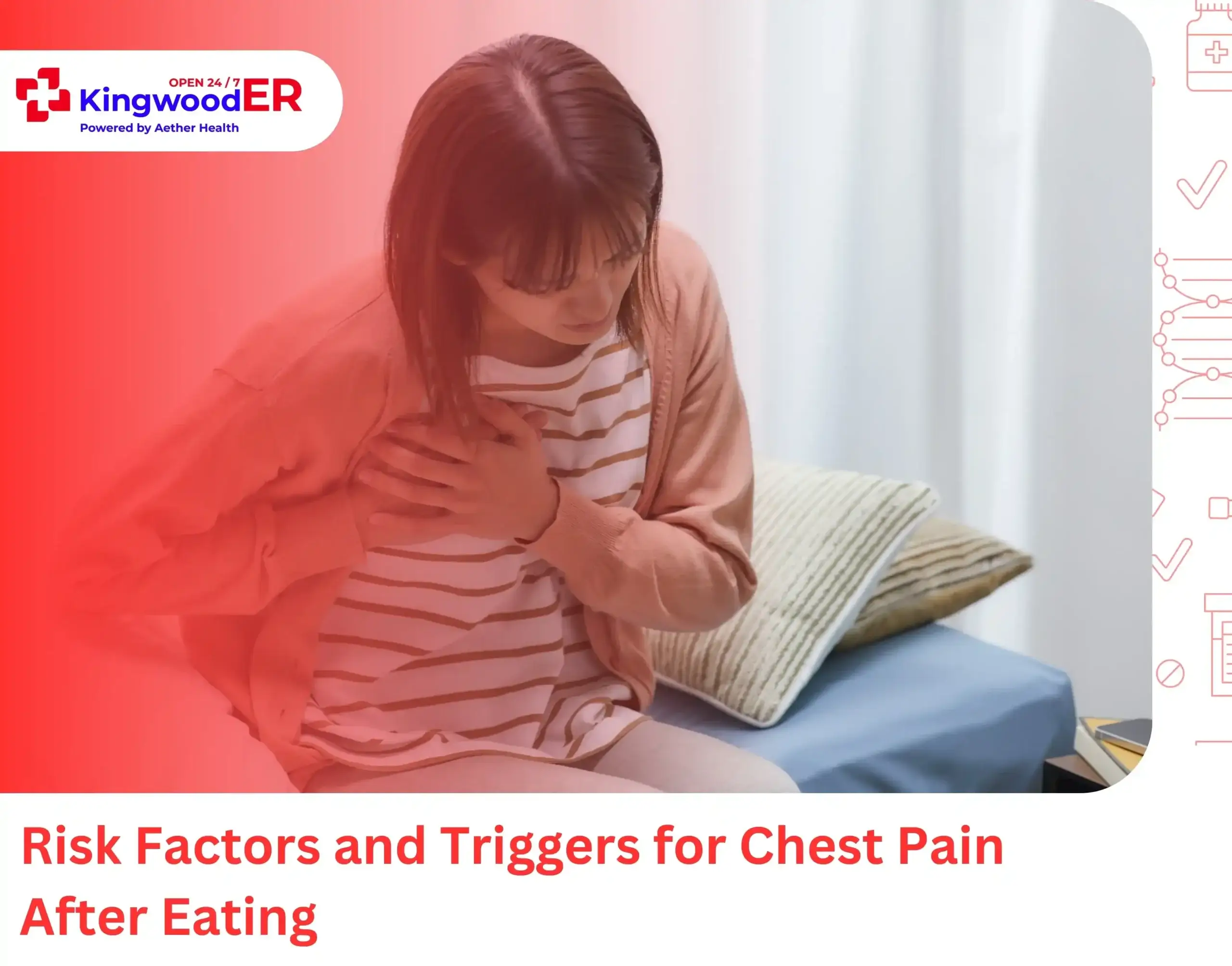
Several lifestyle and health factors can make chest pain more likely after meals. Key contributors include:
- Age: Digestive issues and related discomfort become more common as you get older.
- Obesity: Increases the risk of GERD and hiatal hernias, which can lead to chest pain.
- Smoking: Weakens the lower esophageal sphincter, making acid reflux more frequent.
- Dietary habits: Large meals, eating too quickly, or lying down right after eating can trigger pain.
- Trigger foods: Spicy dishes, citrus fruits, tomatoes, chocolate, caffeine, alcohol, and fatty foods are common culprits.
- Stress and anxiety: Emotional stress disrupts digestion and heightens sensitivity to pain.
Managing your weight, avoiding trigger foods, and practicing healthy eating habits can significantly reduce chest pain after eating.
When to Seek Medical Attention for Chest Pain After Eating
While chest pain after eating is often benign, certain warning signs require immediate medical attention. Seek emergency care if you experience severe chest pain accompanied by shortness of breath, sweating, nausea, dizziness, or pain radiating to your arms, jaw, or back. These symptoms could indicate a heart attack, which requires prompt treatment.
You should also consult a healthcare provider if chest pain after eating occurs frequently, interferes with your daily activities, or doesn’t respond to over-the-counter treatments.
Moreover, seek medical attention if you experience difficulty swallowing, unexplained weight loss, persistent vomiting, or if your symptoms worsen over time.
Treatment and Management Strategies for Chest Pain After Eating
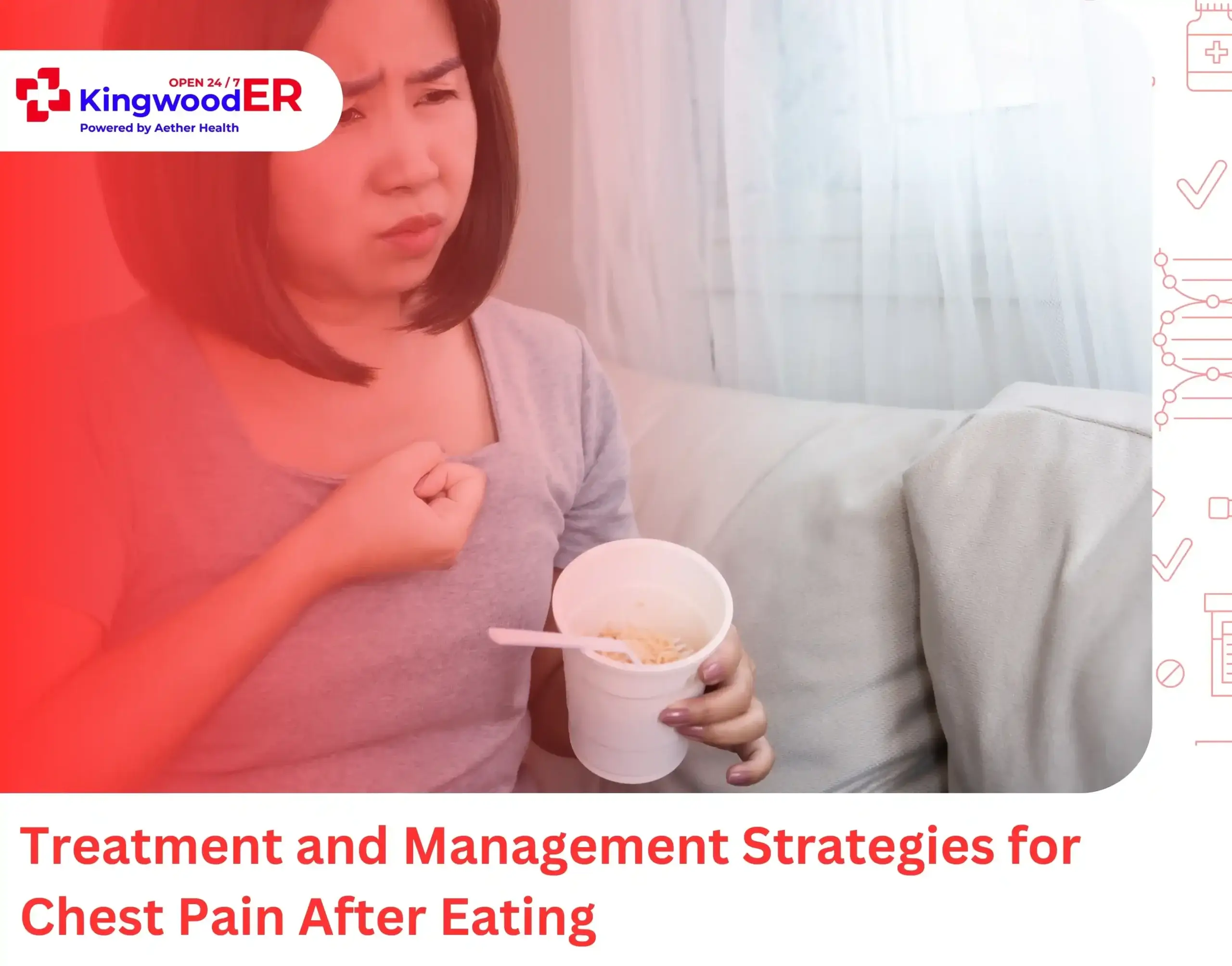
Managing chest pain after eating often involves a combination of lifestyle modifications and, when necessary, medical treatment. Dietary changes are typically the first line of defense. Eating smaller, more frequent meals can reduce the likelihood of triggering symptoms. Avoiding known trigger foods and eating slowly while chewing thoroughly can also help.
For GERD-related chest pain after eating, elevating the head of your bed and avoiding lying down for at least three hours after meals can provide relief. Over-the-counter antacids, H2 blockers, or proton pump inhibitors may help reduce acid production and alleviate symptoms.
Stress management techniques, including regular exercise, meditation, or counseling, can help address the emotional factors that may contribute to digestive issues. Maintaining a healthy weight and quitting smoking are also important steps in reducing symptoms.
Key Takeaway
Chest pain after eating is often tied to digestive issues, but it’s important to know when symptoms may signal something more serious. While lifestyle adjustments and awareness of food triggers can bring relief, sudden, severe, or persistent chest discomfort requires prompt medical attention.
At Aether Health – Kingwood ER, our board-certified physicians provide state-of-the-art emergency care in a safe, comfortable environment. Whether for adults or children, we’re committed to giving each patient the time, attention, and quality treatment they need to feel confident in their health.
FAQs
1. How to relieve GERD chest pain fast?
GERD-related chest pain after eating often improves by sitting upright, sipping warm water, and avoiding lying down right after meals. Over-the-counter antacids may also provide quick relief.
2. What digestive problems cause chest pain?
Common causes of chest pain after eating include acid reflux, GERD, gastritis, ulcers, gallstones, and even esophageal spasms. Identifying the root cause helps guide proper treatment.
3. What to drink for chest pain?
For chest pain after eating, warm drinks often help ease discomfort. Ginger tea, chamomile tea, or warm water can relax the digestive tract and reduce bloating.
4. How to remove trapped gas in the chest?
Walking, light stretching, gentle abdominal massage, or drinking warm fluids can ease trapped gas that sometimes leads to chest pain after eating.
5. Where is gas pain usually located?
Gas pain is usually felt in the upper abdomen, but it can also move into the chest, leading some people to mistake it for heart pain.

